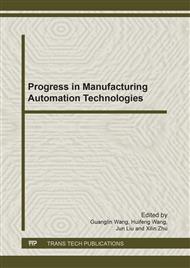p.168
p.173
p.177
p.181
p.186
p.192
p.198
p.202
p.210
Study on Uniform Magnrtorheological Finishing Technology with Changeable Removal Rate Model Based on Rheological Effect
Abstract:
At present, the finish machining process of workpiece with free-form surface has the disadvantages of complex trajectory planning, low machining efficiency and precision. To solve these problems, a material removal model whose removal rate model can change with the profile of the workpiece is proposed in this paper. The working mechanism of this method is described as follows: the rheological effect of magnrtorheological fluid is used to change the magnetic field distribution in finishing areas; then the finishing pressure distribution is changed, that makes the material removal rate of every point in the contact area be approximately equal so the aim of uniform removal is achieved. The experiments identify the quantitative relationship between magnetic field intensity and finishing pressure. Contrast experiments of finishing and removal effects are performed under the different conditions of magnetic field distribution. The experiments results show that the proposed method is feasible and this method has the potential of obtaining the ultra precision.
Info:
Periodical:
Pages:
186-191
Citation:
Online since:
July 2011
Authors:
Price:
Сopyright:
© 2011 Trans Tech Publications Ltd. All Rights Reserved
Share:
Citation:


